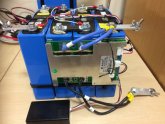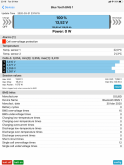Pierre
Somewhere down South
- Joined
- Dec 21, 2019
- Messages
- 1,130
Until recently I have been using Daly Common Port BMS's in my experimental 12v LiFE 100Ah 4S battery pack. Very pleasing results getting in excess of 1500Wh on the discharge cycles. 'Curiosity killed the Cat' and after reading / watching Will experimenting with Bluetooth BMS's I decided that I wanted to see what goes on inside the 'brain' . I promptly ordered a DGJBD 4s 100a unit from China for $68 plus shipping.
I was pleasantly surprised when it arrived - very nice piece of kit, well made and comes with a bluetooth dongle and RS232 / USB converter and cable to connect
to PC. Wired it all up and downloaded JBD Tools V1.6 and iOS app and started experimenting. The manual, which I had to download, is quite well written bar a few
translation issues. Bluetooth as well as the serial connection work extremely well and connections are established within a few seconds. All the settings are accessible via both communication media and I am still happily experimenting with tweaking / adjusting parameters and have built up a collection of 7 different configurations.
The unit has two built-in temp. sensors and the one is on a short fly lead for strategic placement and both can be calibrated. All the other protection actions like
pack and individual cell over / under voltages , over current , cell balancing etc work very well.
The only issue I have is the calibration of the current sensing circuitry - one is supposed to be able calibrate (1) idle current (2) charge current and (3) discharge current and the device will then calculate the resultant current flow and display the result in the app. I have contacted the supplier, who then refers it to the engineer, on numerous occasions but they keep on telling me to follow the manual or to detach / re-attach all the connections to the BMS. This seems silly as all the other functions work perfectly. I think that something is lost 'in translation' due to the language barrier. The current indications have no correlation with the actual current flows , not even ratio wise. Maybe someone on the forum has experience with this particular BMS and can help me solve my 'finger trouble'
My overall impression of the device / monitoring software is very possitive and the coup de grace will be to resolve the current indication.
Looking forward to your replies / recommendations.
I was pleasantly surprised when it arrived - very nice piece of kit, well made and comes with a bluetooth dongle and RS232 / USB converter and cable to connect
to PC. Wired it all up and downloaded JBD Tools V1.6 and iOS app and started experimenting. The manual, which I had to download, is quite well written bar a few
translation issues. Bluetooth as well as the serial connection work extremely well and connections are established within a few seconds. All the settings are accessible via both communication media and I am still happily experimenting with tweaking / adjusting parameters and have built up a collection of 7 different configurations.
The unit has two built-in temp. sensors and the one is on a short fly lead for strategic placement and both can be calibrated. All the other protection actions like
pack and individual cell over / under voltages , over current , cell balancing etc work very well.
The only issue I have is the calibration of the current sensing circuitry - one is supposed to be able calibrate (1) idle current (2) charge current and (3) discharge current and the device will then calculate the resultant current flow and display the result in the app. I have contacted the supplier, who then refers it to the engineer, on numerous occasions but they keep on telling me to follow the manual or to detach / re-attach all the connections to the BMS. This seems silly as all the other functions work perfectly. I think that something is lost 'in translation' due to the language barrier. The current indications have no correlation with the actual current flows , not even ratio wise. Maybe someone on the forum has experience with this particular BMS and can help me solve my 'finger trouble'
My overall impression of the device / monitoring software is very possitive and the coup de grace will be to resolve the current indication.
Looking forward to your replies / recommendations.






